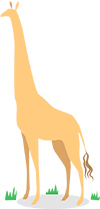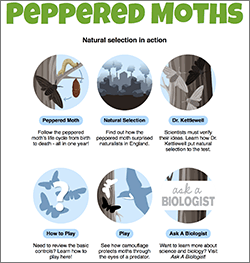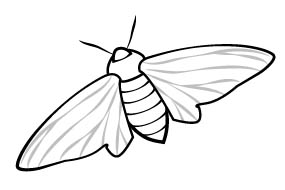
Illustrated by: James Baxter, Sabine Deviche
An Introduction to Natural Selection
A female giraffe walks up to a tree with leaves just out of reach. She lifts her head and stretches her long neck, barely reaching the green leaves of the tree. As she eats more and more leaves off of tall trees, her neck seems to have grown a little bit longer. This giraffe is pregnant with a baby giraffe. When the baby grows to be full size, will it have a longer neck because the mother giraffe stretched so much?

Let's picture a different scene now. Think about a forest filled with trees that have light-colored bark. The air pollution in the area gets bad over time, and the color of the tree bark starts changing from light to dark. Suddenly, light moths that were previously camouflaged are now easily found by birds. Will light moths be common in the next generation?
These examples all focus all relate to the same main questions: How is a trait passed to an organism's offspring and how does it spread through a population?
This week, you will discuss ideas of natural selection with your class, play a selection-based game, and take a trip through time to see how scientists of the past figured out just how a trait is passed from a parent to its offspring.
What You Need
- PowerPoint presentation (your teacher has this)
- One pre-lesson quiz
- Post-lesson quiz
- In-class worksheet
- Pen or pencil
If you are completing the rice activity, you will also need:
- Light and dark bark (or crumpled light and dark construction paper)
- Small bag of wild rice
- Small empty bag
- Forceps (like tweezers)
- Timer or stopwatch
If you are completing the moth hunting activity, you will also need:
- Access to a computer
Before You Begin
The very first thing you should do is answer all the questions on the pre-lesson quiz. This one has PRE written in the top corner. Don't worry, this first one is not for points! When you've completed the quiz, make sure your name is on it and turn it into your teacher.
Procedure
ENGAGE: Giraffe Example

1. Look and listen closely to the pictures and presentation shown by your teacher. Follow along with the presentation, thinking about the pictures and questions presented and discussing them with your classmates.
2. After you and your class have finished talking about the giraffe's traits and how they developed, discuss this hypothetical situation:
Imagine two pairs of giraffes: one pair with a male and female that eat only from the tops of tall trees, and one pair that eats from the lower branches of trees.
3. Listen to the rest of the teacher's presentation. Then, pick one of the following questions and write the question and your answer on your classroom worksheet. This is individual work, do not work in groups.
- How did giraffes as a species get such a long neck?
- Will giraffe babies be similar or different than their parents? Why?
- How are traits, such as a long neck, passed down from parents to offspring?
4. Discuss your answers as a group and explore how these ideas might apply to birds with different sized beaks.
EXPLORE: Computer Simulation OR Rice Activity
If using the computer simulation, follow these directions:

5. Open the game and click on the bird icon (bottom middle) to play "bird's eye view" of selection. Read the instructions and play a game in the light forest. Record your results on the classroom worksheet.
6. Revisit the bird icon and play a game in the dark forest. Record your results on the classroom worksheet.
7. After you've played in both the light and dark forest, click on the power plant icon (top middle) to learn about the background for the game you just played.
8. Click on the black and white moths icon (top right) to visit an explanation of Dr. Kettlewell's experiments. Read through the explanation of his experiments and predictions.
9. Skip down to step number 13, below.
If using the rice activity, follow these directions:

5. Teachers will assign small groups of 2 to 3 students. Each group should get a piece of light bark (or construction paper), a pair of forceps, and a bag of wild rice. Make sure to crumple and then re-flatten the construction paper.
6. Student #1 will set up the activity by counting out 15 white grains of rice and 15 dark grains of rice and spreading them out on the crumpled paper.
7. Student #2 will get out the stopwatch to time rice hunting. Student #3 should have the forceps and be ready to start "catching" rice with the forceps during a 10-second time interval. Make sure to only grab one piece of rice with each peck of the forceps. Collect the captured rice in the empty bag.
8. Clear off the remaining rice from the paper and count how many white grains and dark grains are left. Record this information in the table in the row for Generation 1.
9. Time for rice to reproduce! Count out the same number of each rice color from the full bag of wild rice and add it to the population. This should double the population.
10. Repeat steps 6 - 8 for three generations. Once you are done and have recorded population changes, calculate the percentage of each rice color in the whole population. Remember that you started out with 50% of each color.
11. Repeat steps 4 - 9 on a dark piece of construction paper.
12. Once you've completed the activity, use the percentages to figure out what was going on in the population. Answer the following questions on your classroom worksheet: Which rice color became more common on each background? Why?
EXPLAIN

13. As a class, discuss the activity you've completed (either the computer simulation or the rice activity). What changes did you observe in your population? Why did this happen?
14. Discuss what would happen if we helped the rice blend in by coloring them to be more camouflaged. In the wild, would this cause the rice's offspring to change color as well?
15. Discuss Lamarck and Darwin's ideas. Which theory drives the appearance of adaptations?
16. Think about species as a whole. If no dark morph had existed in this species, what could have happened? If more changes affected one population of these moths, might they gather enough new traits to be considered a new species?
17. Listen and learn as the teacher presents Weismann's mouse tail experiment. What would you expect to find from this experiment?
18. Participate in the discussion of adaptations for each of the following questions:
- How can a trait or characteristic benefit an individual?
- What does "survival of the fittest" mean?
- How does an adaptation begin?
- How does a trait spread within a population?
- What factors might cause some animals to survive while others don't?
ELABORATE
19. As a class and with the help of your teacher, decide on definitions for the following terms:
- Fitness
- Adaptation
- Natural selection
- Heritability
- Mutation
20. Read The Peppered Moth: A Seasoned Survivor.
21. Discuss how the ideas you've learned apply to some of the following examples of adaptations: bird feet, cacti, insects, and pesticide resistance.
22. Try to think of human adaptations and how they increase our reproductive success (fitness) in the context of our habitat.
EVALUATE
23. Complete the post-lesson quiz. This one has POST written in the corner. Make sure your teacher has both your pre- and post-lesson quizzes.
When this activity was first designed, Robin Greene, Karla Moeller, and Megan Rowton were all graduate students in Arizona State University's School of Life Sciences. They designed the activity for a Scientific Teaching course.
Additional images via Wikimedia Commons. Giraffe eating by Muhammad Mahdi Karim. Light and dark peppered moths by Martinowksy at Dutch Wikipedia. Wild rice by Earth100.
Bibliographic details:
- Article: Sooty Selection
- Author(s): Megan Rowton, Karla Moeller, Robin Greene
- Publisher: Arizona State University School of Life Sciences Ask A Biologist
- Site name: ASU - Ask A Biologist
- Date published: 20 Jul, 2015
- Date accessed:
- Link: https://askabiologist.asu.edu/experiments/sooty-selection
APA Style
Megan Rowton, Karla Moeller, Robin Greene. (Mon, 07/20/2015 - 11:44). Sooty Selection. ASU - Ask A Biologist. Retrieved from https://askabiologist.asu.edu/experiments/sooty-selection
Chicago Manual of Style
Megan Rowton, Karla Moeller, Robin Greene. "Sooty Selection". ASU - Ask A Biologist. 20 Jul 2015. https://askabiologist.asu.edu/experiments/sooty-selection
MLA 2017 Style
Megan Rowton, Karla Moeller, Robin Greene. "Sooty Selection". ASU - Ask A Biologist. 20 Jul 2015. ASU - Ask A Biologist, Web. https://askabiologist.asu.edu/experiments/sooty-selection

How are animals so well matched to their habitats? Learn more about how animals change with the environment in our companion story, The Peppered Moth: A Seasoned Survivor.
Download the Sooty Selection Experiment (PDF) and the Sooty Selection PowerPoint
Be Part of
Ask A Biologist
By volunteering, or simply sending us feedback on the site. Scientists, teachers, writers, illustrators, and translators are all important to the program. If you are interested in helping with the website we have a Volunteers page to get the process started.
